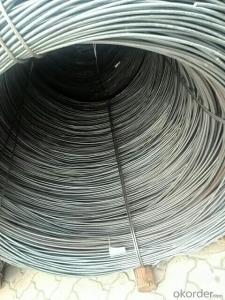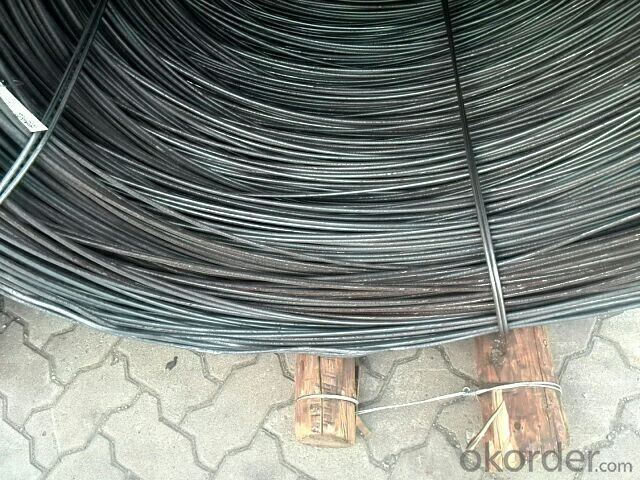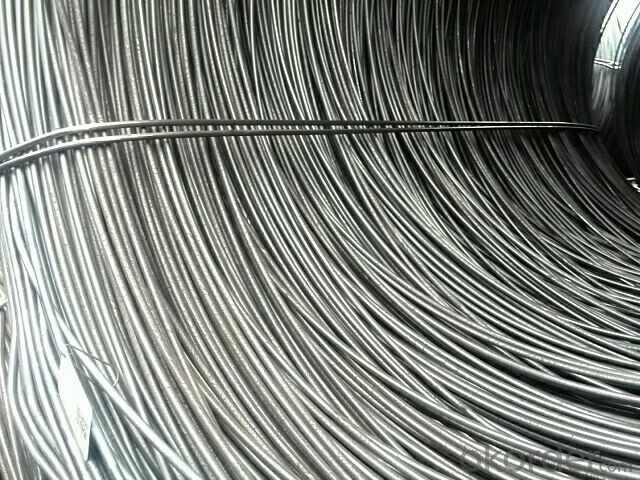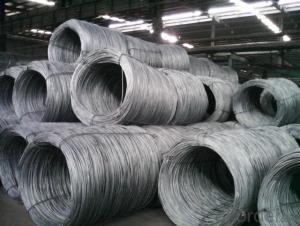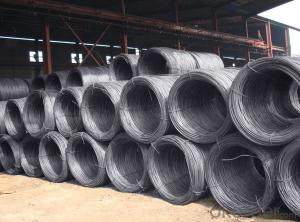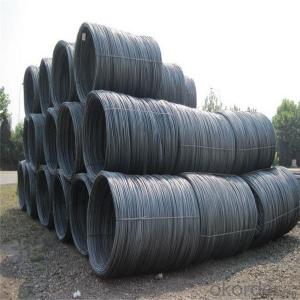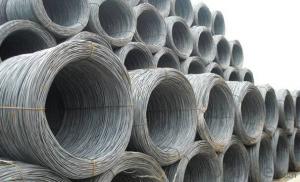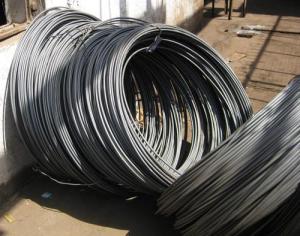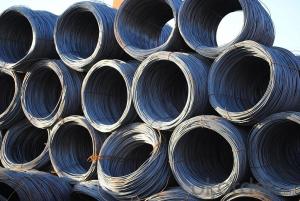Sae1008B AND Sae1006B High quality Wire Rod
- Loading Port:
- Tianjin
- Payment Terms:
- TT OR LC
- Min Order Qty:
- 100 m.t
- Supply Capability:
- 20000 m.t/month
OKorder Service Pledge
OKorder Financial Service
You Might Also Like
Product Description:
OKorder is offering Sae1008B AND Sae1006B High quality Wire Rod at great prices with worldwide shipping. Our supplier is a world-class manufacturer of steel, with our products utilized the world over. OKorder annually supplies products to European, North American and Asian markets. We provide quotations within 24 hours of receiving an inquiry and guarantee competitive prices.
Product Applications:
Sae1006B AND Sae1008B High quality Wire Rod are ideal for structural applications and are widely used in the construction of buildings and bridges, and the manufacturing, petrochemical, and transportation industries.
Product Advantages:
OKorder's Sae1008B AND Sae1006B High quality Wire Rodare durable, strong, and resist corrosion.
Main Product Features:
· Premium quality
· Prompt delivery & seaworthy packing (30 days after receiving deposit)
· Corrosion resistance
· Can be recycled and reused
· Mill test certification
· Professional Service
· Competitive pricing
Product Description:
Specifications of Sae1006B AND Sae1008B High quality Wire Rod :
Steel Grade: sae1006+sae1008B , Standard: GB Diameter: 5.5mm, 6.5mm, 7mm,8mm,9mm,10mm,12mm,14mm
Diameter Tolerance:±0.3mm 6.5mm can be drawing into 2mm/8.0mm can be drawing into 3mm
Brand Name: N-RIVER Place of Origin: Hebei, China Mainland Application: construction, building etc
Chemical Composition:
Please kindly find our chemistry of our material based on Q235 as below for your information
Trademark | Rank | Chemical composition (quality score) % | ||||||
C | Si | Mn | S | P | ||||
| ≤ |
| ≤ | ≤ | ||||
Q235 | A | 0.14-0.22 | 0.30 | 0.30-0.65 | 0.050 | 0.045 | ||
Q235 | B | 0.12-0.20 | 0.30 | 0.30-0.70 | 0.045 | 0.045 | ||
Trademark | Rank | Pulling Test | ||||||
Bend PointΔs/Mpa | Tensile Strength | Elongation Ratioδ5% | ||||||
Thickness (Diameter) /MM | Thickness (Diameter) /MM | |||||||
≤16 | 16-40 | ≤16 | 16-40 | |||||
≥ | ≥ | |||||||
Q235 | A | 235 | 225 | 375-500 | 26 | 25 | ||
Q235 | B | 235 | 225 | 375-500 | 26 | 25 | ||
Usage and Applications of Sae1008B AND Sae1006B High quality Wire Rod :
After hot-rolled the products shaped into coil and delivery as finished product, including round, square, rectangular, hexagonal and so on. Since most of the products are round, it is generally called wire rod. Carbon steel wire rod is widely used in construction and manufacturing. Carbon steel wire rod is mainly used for reinforcement of reinforced concrete and welded structure or reprocessed (roberts , nail, etc.) materials, especially used to produce wire drawing, welding electrode, nails, spring, electronic, precise machinery parts and so on.
Packaging & Delivery of Wire Rod Sae1006B AND Sae1008B :
Packaging Detail: products are packed in coil and then shipped by container or bulk vessel
Each coil weight: 2-3MT
Delivery Detail: within 45 days after received deposit or LC.
Label: to be specified by customer, generally, each bundle has 1-2 labels
Trade terms: FOB, CFR, CIF
FAQ:
Q1: Why buy Materials & Equipment from OKorder.com?
A1: All products offered byOKorder.com are carefully selected from China's most reliable manufacturing enterprises. Through its ISO certifications, OKorder.com adheres to the highest standards and a commitment to supply chain safety and customer satisfaction.
Q2: Can stainless steel rust?
A2: Stainless does not "rust" as you think of regular steel rusting with a red oxide on the surface that flakes off. If you see red rust it is probably due to some iron particles that have contaminated the surface of the stainless steel and it is these iron particles that are rusting. Look at the source of the rusting and see if you can remove it from the surface.
Q3: What is the normal tolerance of Hot Rolled Mild Steel Angle Beams for Structures and for Buildings?
A3: Normally 3%-5%, but we can also produce the goods according to the customers' requests.
Images:
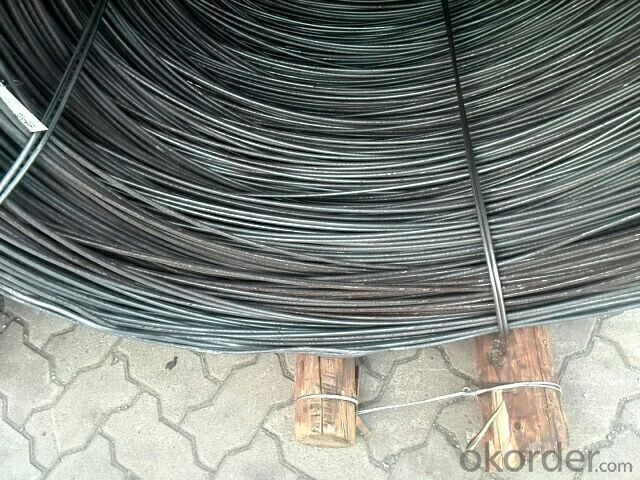
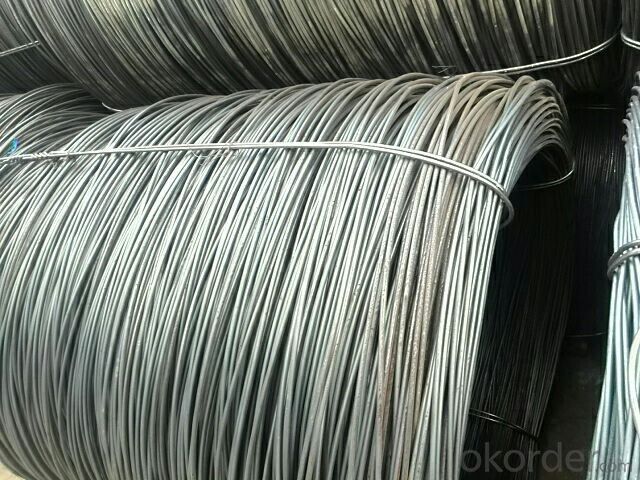
- Q: What are the common industry standards for steel wire rod professionals?
- The common industry standards for steel wire rod professionals include adhering to the specifications set by organizations like the American Society for Testing and Materials (ASTM) and the International Organization for Standardization (ISO). These standards cover aspects such as chemical composition, mechanical properties, dimensions, and tolerances, ensuring consistency and quality in the production and use of steel wire rods.
- Q: What are the main factors influencing the choice of steel wire rod order confirmation process?
- The main factors influencing the choice of steel wire rod order confirmation process can vary depending on various aspects of the business and industry. However, some common factors that typically have an impact on this decision include: 1. Customer requirements: The specific requirements and preferences of customers play a crucial role in determining the order confirmation process. Some customers may prefer a more streamlined and automated process, while others may require more personalized and manual confirmation methods. 2. Order complexity: The complexity of the steel wire rod order can also influence the choice of confirmation process. If the order involves multiple specifications, customizations, or special requirements, a more detailed and thorough confirmation process may be necessary to ensure accuracy. 3. Order volume: The volume of orders received by the business can also impact the choice of confirmation process. For smaller order volumes, a simpler and less time-consuming process may be sufficient. Conversely, larger order volumes may require a more efficient and automated confirmation process to handle the increased workload. 4. Time sensitivity: The urgency or time sensitivity of the order is another factor to consider. If the order needs to be confirmed quickly to meet tight deadlines, a streamlined and expedited confirmation process may be necessary. 5. Internal capabilities: The internal capabilities and resources of the business also play a role in determining the order confirmation process. If the business has advanced technology and systems in place, it may be able to implement a more automated and efficient confirmation process. On the other hand, if resources are limited, a more manual and time-consuming process may be the only viable option. 6. Industry standards and regulations: Certain industries have specific standards and regulations that dictate the order confirmation process. Compliance with these standards is essential, and the choice of confirmation process may need to align with industry requirements. 7. Risk management: The level of risk associated with the order can influence the choice of confirmation process. If there are potential risks or uncertainties involved, a more comprehensive and detailed confirmation process may be necessary to minimize errors or discrepancies. Overall, the choice of steel wire rod order confirmation process should be determined by a careful evaluation of these factors to ensure efficient, accurate, and customer-centric order processing.
- Q: How is steel wire rod used in the manufacturing of wire for power transmission lines?
- The manufacturing process for wire used in power transmission lines relies heavily on steel wire rod. This essential component serves as the raw material for creating high-strength conductors that carry electrical energy across vast distances. To begin the manufacturing process, high-quality steel wire rods are carefully selected. These rods are typically made from either carbon steel or alloy steel. They then undergo a series of processes, including heating, rolling, and drawing, to transform them into wires with specific diameters and strengths. The primary role of the steel wire rod is to provide the necessary mechanical strength and conductivity required for power transmission lines. Steel is known for its exceptional tensile strength, which enables the wire to withstand the immense tension and stress experienced during installation and operation of transmission lines. Moreover, steel wire rod offers excellent electrical conductivity. This means that it allows electricity to flow efficiently through the wire, minimizing power loss and ensuring optimal transmission efficiency over long distances. The manufactured wire, which is made from steel wire rod, is typically stranded together to create a conductor. Multiple layers of these steel wire strands are then wound around a central core to form a composite conductor. This design enhances the wire's strength and flexibility, making it suitable for enduring extreme weather conditions, wind, and ice loads. Furthermore, steel wire rod plays a critical role in ensuring the durability and reliability of power transmission lines. Its corrosion resistance properties protect the wire from environmental factors such as moisture and chemical exposure, which could otherwise compromise the integrity of the line. To summarize, steel wire rod is essential in the manufacturing of wire for power transmission lines due to its exceptional tensile strength, electrical conductivity, and corrosion resistance properties. It enables the production of high-quality conductors that can efficiently transmit electrical energy over long distances while enduring various environmental challenges and ensuring uninterrupted power supply.
- Q: How does the elongation of steel wire rod vary with different wire drawing processes?
- The elongation of a steel wire rod can vary depending on the specific wire drawing process employed. Wire drawing is a metalworking process that involves pulling a metal wire rod through a series of dies to reduce its diameter and increase its length. Different wire drawing processes, such as cold drawing or hot drawing, can impact the elongation of the steel wire rod. Cold drawing involves pulling the wire rod through a die at room temperature, while hot drawing involves heating the wire rod and then pulling it through the die. In general, the elongation of a steel wire rod tends to be greater in hot drawing compared to cold drawing. This is because the heat softens the steel, making it more ductile and easier to deform. As a result, the wire rod can undergo greater elongation without breaking or fracturing. In cold drawing, the steel wire rod undergoes less elongation due to its lower ductility at room temperature. The cold drawing process may require multiple passes through different dies to achieve the desired reduction in diameter and increase in length. However, the overall elongation may be relatively lower compared to hot drawing. Additionally, factors such as the reduction ratio, die design, lubrication, and speed of the wire drawing process can also influence the elongation of the steel wire rod. Higher reduction ratios (the difference in diameter before and after each pass) generally result in greater elongation. Proper die design and lubrication can minimize friction and improve the wire's ability to elongate. The speed of the wire drawing process can also affect elongation, as excessive speed can cause tension and decrease elongation. Overall, the elongation of a steel wire rod varies with different wire drawing processes. Hot drawing typically allows for greater elongation due to the increased ductility of the steel at higher temperatures, while cold drawing may result in relatively lower elongation. The specific process parameters and conditions, such as reduction ratio, die design, lubrication, and speed, also play a significant role in determining the elongation of the wire rod.
- Q: How is steel wire rod used in the manufacturing of wire harnesses?
- Steel wire rod is used in the manufacturing of wire harnesses as it serves as the primary material for the conductive wires within the harness. The wire rod is first drawn into the desired diameter and then processed further to remove any impurities or surface defects. These high-quality wires are then twisted, braided, or insulated to create the necessary configuration for the wire harness, providing the required strength, flexibility, and electrical conductivity. Overall, steel wire rod plays a crucial role in ensuring the durability and performance of wire harnesses in various industries, including automotive, aerospace, and electronics.
- Q: What are the alloying elements used in steel wire rod production?
- The alloying elements commonly used in steel wire rod production include carbon, manganese, silicon, and sometimes elements like chromium, nickel, and molybdenum for specific applications.
- Q: How is steel wire rod used in the manufacturing of electrical wires?
- Steel wire rod is used in the manufacturing of electrical wires as the primary raw material. It is typically drawn through a series of dies to reduce its diameter and increase its length, resulting in a thin and flexible wire. This wire is then used to conduct electricity in various electrical applications, including power transmission, telecommunications, and electrical appliances.
- Q: What are the advantages of using steel wire rod over other materials?
- Steel wire rod offers numerous advantages compared to other materials. Firstly, its exceptional strength and durability make it ideal for applications requiring reliability. It can withstand heavy loads and stresses, making it suitable for industries such as construction, automotive, and manufacturing. Secondly, steel wire rod is highly versatile as it can be easily fabricated into various shapes and sizes to meet specific project requirements. This flexibility allows for a wide range of applications, including wire ropes, springs, cables, fencing, and reinforcement in concrete structures. Moreover, steel wire rod exhibits excellent corrosion resistance properties, ensuring a longer lifespan and reduced maintenance costs. This makes it suitable for outdoor and marine applications, where exposure to moisture and harsh weather conditions is common. Additionally, steel wire rod is cost-effective due to its abundance and widespread availability. Its durability and resistance to wear and tear also contribute to lower replacement and maintenance costs in the long run. Lastly, steel wire rod promotes environmental sustainability as steel is one of the most recycled materials globally. Using steel wire rod helps conserve natural resources and reduce carbon emissions by reducing the need for new production. In summary, the advantages of steel wire rod include its exceptional strength, versatility, corrosion resistance, cost-effectiveness, and environmental sustainability. These qualities make it a preferred choice for a wide range of applications across different industries.
- Q: What are the different impact testing methods for steel wire rod?
- There are several different impact testing methods that can be used to assess the mechanical properties of steel wire rods. These methods help determine how well the wire rods can withstand sudden impact or shock loading, which is crucial in various applications such as construction, automotive, and aerospace industries. Some of the commonly used impact testing methods for steel wire rods include: 1. Charpy Impact Test: This method involves striking a notched or V-notch specimen with a pendulum hammer to measure the energy absorbed during fracture. The test measures the toughness of the material and is widely used due to its simplicity and ease of implementation. The results are typically reported as the energy absorbed in joules. 2. Izod Impact Test: Similar to the Charpy test, the Izod test also measures the energy absorbed during fracture. However, in this method, the specimen is clamped vertically, and the pendulum strikes it at the opposite side of the notch. The test provides information about the material's resistance to sudden impact. 3. Drop Weight Test: In this method, a weight is dropped from a specified height onto a wire rod specimen. The energy absorbed during fracture is measured, and the test is useful in determining the material's ability to withstand impact loading under specific conditions. 4. Dynamic Tear Test: This test evaluates the fracture toughness of steel wire rods by measuring the energy required to propagate a pre-existing crack through the specimen. The test involves applying a load to the specimen, either by a pendulum or a hydraulic system, and monitoring the crack propagation. 5. Ballistic Pendulum Test: This method determines the velocity of a small projectile before and after striking the wire rod specimen. By measuring the change in velocity, the impact resistance of the material can be evaluated. The test is commonly used for high-strength steel wire rods. Each of these impact testing methods has its own advantages and limitations, and the choice of the method depends on various factors such as the specific application, material properties, and test requirements. It is essential to select an appropriate testing method that accurately reflects the intended use of the steel wire rod and ensures its performance and reliability in real-world scenarios.
- Q: What are the different surface defects that can affect the ductility of steel wire rod?
- Some of the different surface defects that can affect the ductility of steel wire rod include cracks, scratches, pits, and scale. These defects can weaken the integrity of the wire rod, leading to decreased ductility and potential failure under stress.
Send your message to us
Sae1008B AND Sae1006B High quality Wire Rod
- Loading Port:
- Tianjin
- Payment Terms:
- TT OR LC
- Min Order Qty:
- 100 m.t
- Supply Capability:
- 20000 m.t/month
OKorder Service Pledge
OKorder Financial Service
Similar products
Hot products
Hot Searches
Related keywords

